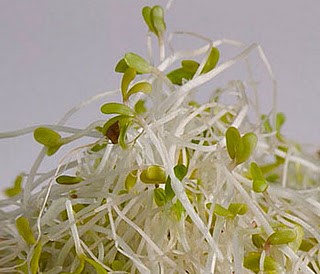I read
Alfalfa is a flowering plant in the pea family Fabaceae cultivated as an important forage crop in the US, Canada, Argentina, France, Australia, the Middle East, South Africa, and many other countries. It is known as lucerne in the UK, France, Australia, South Africa and New Zealand, and known as lucerne grass in south Asia. It superficially resembles clover, with clusters of small purple flowers.
... therefore, I think!
In Canada, in French it is also called LUZERNE ... like Luzern ou Lucerne ... it's all the the spelling and how it sounds ...
So, whenever I was thinking that I was driving to Luzern ... the only thing that was coming to mind was the little sprouts! Cracking up myself ! ha ha ha ... I am so funny.
What I've discovered was very very nice!
Luzern is located in the German-speaking part of Switzerland, at the foot of the Swiss Alps (wow and rewow). I say it again, I love mountains.
So what did I see? A wonderful city !
I was lucky to find a parking space near by the old part of town. After a short walk, I was at the Main Railway Station which was totally rebuilt in 1984 and 1991 after a fire completely destroyed it. All that "survived" was the main portal.
From there I went toward the Lake to the Convention Center
I've continued my walk following the Reuss River.
Three things to note of the follow picture:
- The Watertower is an octogonal tower that was built around 1300. It is 43 meters high and over the years has been used as a prison, for archives, treasury and a torture chamber
- The Bridge: Kapellbrücke or Chapel Bridge: is one of the multiple wooden bridges of Switzerland. It is 204 meters long footbridge and was built in 1333. However, a smoker left a still lit cigarette in 1993 and the bridge and most paintings were destroyed but was quickly rebuilt ...The tower and the bridge are Lucerne's trademark and form the most photographed monument in the country.
- I have just talked about paintings ... well that covered bridge is home to more than 100 paintings dating from the 17th century and representing scenes of Switzerland and its history.
Lake Lucerne flows into the Reuss River, but how it the water level controlled?
Technically, this is a unique sight. The so-called "spikes" are lowered into or withdrawn from the water manually. It was built in 1859-60, replacing the Reuss steps that channelled the water over the city mills.
Two churches have attracted my attention.
The Jesuit Church was built in 1666 by Father Christoph Vogleer. It was the first large scle Baroque church to be built in Switzerland. Luzern is still mainly following the Roman Catholic Church.
The other one : the Hof Church is Lucerne's main church. It was built on a small hill east of the medieval downtown. It still somewhat dominates the scene of the city with its gothic twin towers. Hof Church belongs to a Benedictine monastery older than the city itself. A first church must have existed at this place as early as the 9th century, but only a few fragments of this period have remained. The gothic twin towers once belonged to a church that has been burnt down on Easter Sunday, 1633. Hof Church as it can be seen today has been built from 1633 to 1644 in Renaissance style with some Baroque elements.
Jesuit Church
Hof Church
The Musegg Wall, built between 1370 and 1442, is part of the historical city fortification that once had 30 towers. What remains of the wall today is 870 metres long, nine metres tall (on average) and 1.5 metres thick.
There are now nine towers, four of which are open to the public during the summer months. Visitors can also walk along the top of the wall. From here there is an impressive view of the city, the lake and the Alpine panorama.
Panoramic view of Luzern.
Luzern from the main tower
... and lastly ... The Hotel Château Gütsch is located about 2,5km west of Luzern and is reached in a few minutes by funicular from Baselstrasse, or uphill on foot. It is on the edge of the Gütschwald and offers breathtaking views of the city, Lake Lucerne and the mountains. The landmark fairytale Château Gütsch dates from the mid-19th century and developed over the years from an initial simple inn to a luxury boutique hotel, restaurant and spa complex which is scheduled to re-open ... in 2012!
Château Gütsch










2 commentaires:
Cette ville est magnifique et tu la décrit très bien... j'espère un jour que tu réaliseras ton rêve.
Mme Simonac
Moi aussi j'espère bien, mais il faudrait que définisse un peu mieux mon rêve pour le réaliser ...
Post a Comment